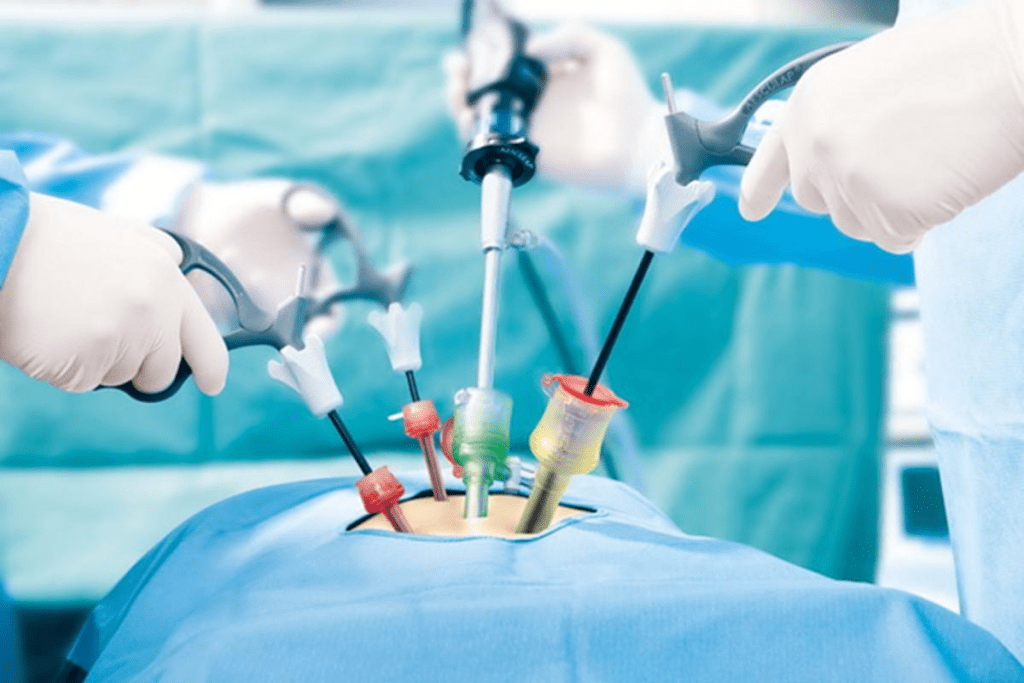Last Updated on October 31, 2025 by

Laser lithotripsy is a top choice for treating kidney stones. But many wonder about the pain it causes. It’s normal to feel nervous about any medical procedure.
Moderate pain is what most people feel during laser lithotripsy. But the pain can change based on a few things. These include where the stone is, how sensitive you are to pain, and if you need a stent after the procedure. Even though stones are small, they can hurt a lot. Laser lithotripsy helps break them up, giving you relief.
We’ll look at what affects how much pain you might feel. We’ll also talk about how long it takes to recover. This will help you know what to expect before, during, and after the treatment.
Laser lithotripsy is a top choice for treating kidney stones. It uses a laser to break stones into small pieces. These pieces can then be removed or passed out in urine.

Laser lithotripsy works by using laser energy to break stones. The doctor explains, “The doctor uses tools through the urethra to reach the stone. Then, the laser breaks it up.” A ureteroscope guides the laser to the stone.
A ureteroscope is used to see the stone. A laser fiber is then inserted to deliver energy. This breaks the stone into smaller pieces.
These pieces can be removed or passed out in urine. Studies show that laser lithotripsy is highly effective. Over 90% of patients are stone-free after one session.
Laser lithotripsy is very effective in removing kidney stones. It has high success rates, making it a reliable choice. The benefits include:
As technology advances, laser lithotripsy will get even better. It will become an even more appealing option for those with kidney stones.
It’s important for patients to know about pain levels during laser lithotripsy. Most people find the pain manageable during and after the surgery. This is true for removing kidney stones.
Most patients say their pain is 4 or less on a 10-point scale a week after. MyHealth.Alberta.ca notes, “You might feel a burning sensation when you pee for hours after. You might also feel the need to pee even if you don’t.” This discomfort usually goes away by itself.
Here are some pain scores patients often report:
We offer different anesthesia options to make the procedure comfortable. The right choice depends on the patient’s needs and their situation.
Here are some common anesthesia options:
Patients’ experiences with pain during lithotripsy vary. But many say it was less painful than they thought. One patient said, “I was surprised at how little pain I felt during and after. The burning sensation while peeing was temporary and not too bad.”

We know every patient’s experience is different. Pain can be influenced by many things. Our team aims to provide personalized care to reduce discomfort and ensure the best results for patients with kidney stones.
Knowing what affects pain after treatment is key to better recovery. Laser lithotripsy has several factors that can change how much pain a patient feels.
The stone’s location and size greatly affect pain after laser lithotripsy. Larger stones or those in harder-to-reach places may cause more pain. Studies show that ureter stones hurt more than kidney stones.
Stone size is also important. Bigger stones need more time and energy to break, leading to more pain.
Everyone feels pain differently, and this affects how much pain they feel after laser lithotripsy. Those who are more sensitive or expect the worst may feel more pain. Healthcare providers need to check pain sensitivity and help manage it.
Ureteral stents after laser lithotripsy can also cause pain. Stents help the ureter stay open, but can irritate and cause discomfort. We help patients deal with stent discomfort to improve their recovery.
How long the laser lithotripsy takes can also impact pain. Longer procedures can cause more pain afterward. Our team works to make procedures as short as possible while removing stones effectively.
Understanding these factors helps us manage pain better for patients getting laser lithotripsy. Good pain management is a big part of our care.
Knowing how long it takes to recover from laser lithotripsy is key. It helps manage expectations and worries about pain after the procedure. Most people see their pain lessen within a week after the treatment.
In the first 24 hours, you might feel some discomfort, like a burning feeling when you pee. Dr. says most stone fragments pass out of your body in 24 hours. It’s important to drink lots of water and follow your care instructions closely to help your body heal.
Between days 2-7, your pain should start to lessen as your body heals. It’s important to keep following your care instructions, including drinking plenty of water and taking pain meds if needed. Most people start to feel much better during this time.
After laser lithotripsy, long-term pain is usually not a big issue. But some people might have ongoing urinary problems. These can include needing to pee more often or feeling like you need to pee right away. These usually go away on their own. If they don’t, you should talk to your doctor.
Understanding the recovery timeline helps patients manage their care better. It reduces discomfort and ensures a good outcome.
Complications after laser lithotripsy are rare but can cause extra pain. We aim to make the procedure as painless as possible. Knowing about these complications helps manage your expectations and recovery.
Infection is a rare complication, happening in less than 10% of cases. Symptoms include fever, chills, and flank pain. It’s key to spot these signs early for quick treatment.
Watch out for these infection signs:
Urinary urgency and frequency are common after laser lithotripsy. These symptoms are usually short-lived. Drinking lots of water and using a heating pad can help.
To ease urinary urgency and frequency:
It’s common to have blood in your pee and discomfort from a stent after the procedure. Managing this discomfort involves medication and lifestyle changes.
Effective ways to manage stent-related discomfort include:
Understanding these complications and how to manage them helps patients navigate their recovery. We’re dedicated to providing full care and support during treatment.
New laser technology has changed lithotripsy for the better. It makes the procedure safer and more effective. This has led to better results for patients.
The thulium fiber laser is a big step forward in lithotripsy. This technology makes procedures shorter. This means less stress and discomfort for patients.
Studies show the thulium fiber laser cuts down on procedure time. It also improves how well the treatment works.
“The thulium fiber laser is a breakthrough in treating kidney stones,” say experts. It’s precise and efficient, making it a top choice for urologists.
Modern lithotripsy is better at hitting the right spot. This means less damage to surrounding tissues. It’s a big improvement.
Modern laser lithotripsy is a big leap from older methods. It’s more effective and safer. There are fewer complications and less pain for patients.
As we keep improving lithotripsy, patients will see even better results. The future of lithotripsy is bright. Ongoing research aims to make it even less painful and more effective.
Laser lithotripsy is a top choice for treating kidney stones. It offers quick relief and has a high success rate in removing stones. Though it can be uncomfortable, the benefits usually make it worth it. We’ve looked at how pain varies, based on stone size and location, how sensitive you are to pain, and if you have a ureteral stent.
Given its success in removing stones, lithotripsy is a good option for many. Knowing what to expect can help you prepare for the treatment and recovery.
Laser lithotripsy is a surgical procedure that breaks down kidney stones. It uses a laser to make the stones smaller. Then, these smaller pieces can be easily passed out in the urine.
The surgery uses a special tool called a ureteroscope. It goes through the urethra and reaches the stone. Then, the laser is turned on to break the stone into smaller pieces.
Laser lithotripsy can be moderately painful. But how much pain varies from person to person. Most people say their pain is 4 or less on a 10-point scale within a week after the surgery.
Several things can affect how much pain you feel. These include the stone’s size and location, how sensitive you are to pain, if you have a ureteral stent, and how long the surgery takes.
Most people start to feel less pain within a week after the surgery. You might feel some discomfort in the first 24 hours. Then, your pain will slowly get better over the next few days.
Some possible complications include infection, trouble with urination, and discomfort from the stent. But these are rare. They can usually be treated with medicine and other methods.
Laser lithotripsy works very well. Over 90% of people can get rid of their stones in just one session.
The thulium fiber laser is a new technology. It makes the surgery faster and better. It’s more precise, which means less damage and fewer complications.
There are different anesthesia options to help you feel less pain during the surgery. You can talk to your healthcare provider about these.
Laser lithotripsy is more effective and safer than older methods. It has better success rates and fewer side effects.
The size of the stone that needs lithotripsy can vary. But, usually, stones that are too big to pass on their own are treated with laser lithotripsy.
Subscribe to our e-newsletter to stay informed about the latest innovations in the world of health and exclusive offers!